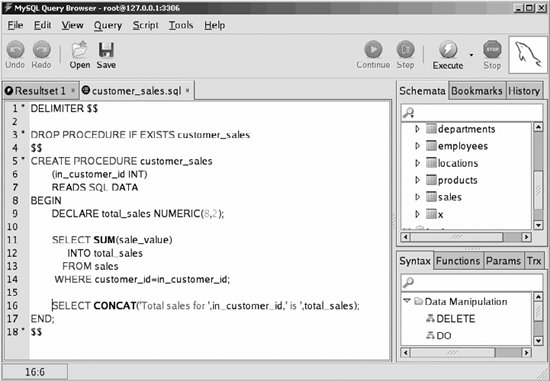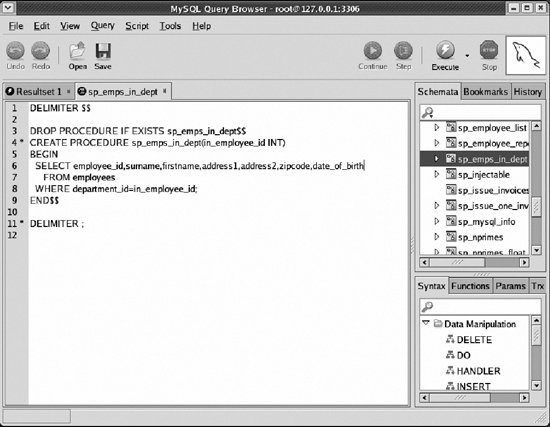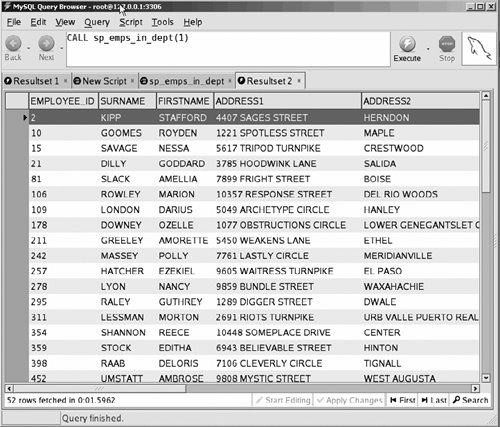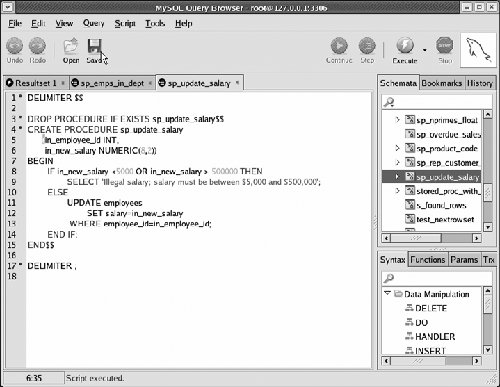Interacting with the Database
Most stored programs involve some kind of interaction with database tables. There are four main types of interactions:
- Store the results of a SQL statement that returns a single row into local variables.
- Create a "cursor" that allows the stored program to iterate through the rows returned by a SQL statement.
- Execute a SQL statement, returning the result set(s) to the calling program.
- Embed a SQL statement that does not return a result set, such as INSERT, UPDATE, DELETE, etc.
The following sections look briefly at each type of interaction.
|
2.8.1. SELECTing INTO Local Variables
Use the SELECT INTO syntax when you are querying information from a single row of data (whether retrieved from a single row, an aggregate of many rows, or a join of multiple tables). In this case, you include an INTO clause "inside" the SELECT statement that tells MySQL where to put the data retrieved by the query.
Figure 2-10 shows a stored procedure that obtains and then displays the total sales for the specified customer ID. Figure 2-6 executes the procedure.
Figure 2-10. A stored procedure with an embedded SELECT INTO statement

Example 2-6. Executing a stored procedure that includes a SELECT INTO statement
mysql> CALL customer_sales(2) $$
+--------------------------------------------------------------+
| CONCAT('Total sales for ',in_customer_id,' is ',total_sales) |
+--------------------------------------------------------------+
| Total sales for 2 is 7632237 |
+--------------------------------------------------------------+
1 row in set (18.29 sec)
Query OK, 0 rows affected (18.29 sec)
|
2.8.2. Using Cursors
SELECT INTO is fine for single-row queries, but many applications require the querying of multiple rows of data. You will use a cursor in MySQL to accomplish this. A cursor lets you fetch one or more rows from a SQL result set into stored program variables, usually with the intention of performing some row-by-row processing on the result set.
The stored procedure in Figure 2-11 uses a cursor to fetch all rows from the employees table.
Here is an explanation of the significant lines in this procedure:
Figure 2-11. Using a cursor in a stored procedure

|
Line(s) |
Explanation |
|---|---|
|
8-12 |
Declare local variables. The first three are created in order to receive the results of our SELECT statement. The fourth (done) lets us know when all the rows have been retrieved from the result set. |
|
14-16 |
Define our cursor. This is based on a simple SELECT that will retrieve results from the employees table. |
|
18 |
Declare a "handler" that defines the actions we will take when no more rows can be retrieved from a SELECT statement. Handlers can be used to catch all kinds of errors, but a simple handler like this is always needed to alert us that no more rows can be retrieved from a result set. |
|
20 |
Open the cursor. |
|
21-26 |
The simple loop that fetches all the rows from the cursor. |
|
22 |
Use the FETCH clause to get a single row from the cursor into our local variables. |
|
23-25 |
Check the value of the done variable. If it is set to 1, then we have fetched beyond the last row within the cursor, so we execute the LEAVE statement to terminate the loop. |
2.8.3. Returning Result Sets from Stored Procedures
An unbounded SELECT statementone not associated with an INTO clause or a cursorreturns its result set to the calling program. We have used this form of interaction between a stored procedure and the database quite a few times already in this book, using simple SELECTs to return some kind of status or result from a stored procedure. So far, we've used only single-row result sets, but we could equally include a complex SQL statement that returns multiple rows within the stored procedure.
If we execute such a stored procedure from the MySQL command line, the results are returned to us in the same way as if we executed a SELECT or SHOW statement. Figure 2-12 shows a stored procedure that contains such an unbounded SELECT statement.
Figure 2-12. An unbounded SELECT statement in a stored procedure

If we execute the stored procedure and supply an appropriate value for the input parameter, the results of the SELECT within the stored procedure are returned. In Figure 2-13 we see the results of the SELECT statement being returned from the stored procedure call from within the MySQL Query Browser.
Figure 2-13. Results returned from a stored procedure that has an unbounded SELECT

Note that a stored program call can return more than one result set. This creates special challenges for the calling program, which we discussfor each specific programming languagein Chapters 13 through 17.
2.8.4. Embedding Non-SELECTs
"Simple" SQL statements that do not return results can also be embedded in your stored programs. These statements include DML statements such as UPDATE, INSERT, and DELETE and may also include certain DDL statements such as CREATE TABLE. Some statementsspecifically those that create or manipulate stored programsare not allowed; these are outlined in Chapter 5.
Figure 2-14 shows a stored procedure that includes an update operation. The UPDATE statement is enclosed in some validation logic that prevents the update from proceeding if the input values are invalid.
Figure 2-14. Stored procedure with an embedded UPDATE

Part I: Stored Programming Fundamentals
Introduction to MySQL Stored Programs
- Introduction to MySQL Stored Programs
- What Is a Stored Program?
- A Quick Tour
- Resources for Developers Using Stored Programs
- Some Words of Advice for Developers
- Conclusion
MySQL Stored Programming Tutorial
- MySQL Stored Programming Tutorial
- What You Will Need
- Our First Stored Procedure
- Variables
- Parameters
- Conditional Execution
- Loops
- Dealing with Errors
- Interacting with the Database
- Calling Stored Programs from Stored Programs
- Putting It All Together
- Stored Functions
- Triggers
- Calling a Stored Procedure from PHP
- Conclusion
Language Fundamentals
- Language Fundamentals
- Variables, Literals, Parameters, and Comments
- Operators
- Expressions
- Built-in Functions
- Data Types
- MySQL 5 Strict Mode
- Conclusion
Blocks, Conditional Statements, and Iterative Programming
- Blocks, Conditional Statements, and Iterative Programming
- Block Structure of Stored Programs
- Conditional Control
- Iterative Processing with Loops
- Conclusion
Using SQL in Stored Programming
- Using SQL in Stored Programming
- Using Non-SELECT SQL in Stored Programs
- Using SELECT Statements with an INTO Clause
- Creating and Using Cursors
- Using Unbounded SELECT Statements
- Performing Dynamic SQL with Prepared Statements
- Handling SQL Errors: A Preview
- Conclusion
Error Handling
- Error Handling
- Introduction to Error Handling
- Condition Handlers
- Named Conditions
- Missing SQL:2003 Features
- Putting It All Together
- Handling Stored Program Errors in the Calling Application
- Conclusion
Part II: Stored Program Construction
Creating and Maintaining Stored Programs
- Creating and Maintaining Stored Programs
- Creating Stored Programs
- Editing an Existing Stored Program
- SQL Statements for Managing Stored Programs
- Getting Information About Stored Programs
- Conclusion
Transaction Management
- Transaction Management
- Transactional Support in MySQL
- Defining a Transaction
- Working with Savepoints
- Transactions and Locks
- Transaction Design Guidelines
- Conclusion
MySQL Built-in Functions
- MySQL Built-in Functions
- String Functions
- Numeric Functions
- Date and Time Functions
- Other Functions
- Conclusion
Stored Functions
- Stored Functions
- Creating Stored Functions
- SQL Statements in Stored Functions
- Calling Stored Functions
- Using Stored Functions in SQL
- Conclusion
Triggers
Part III: Using MySQL Stored Programs in Applications
Using MySQL Stored Programs in Applications
- Using MySQL Stored Programs in Applications
- The Pros and Cons of Stored Programs in Modern Applications
- Advantages of Stored Programs
- Disadvantages of Stored Programs
- Calling Stored Programs from Application Code
- Conclusion
Using MySQL Stored Programs with PHP
- Using MySQL Stored Programs with PHP
- Options for Using MySQL with PHP
- Using PHP with the mysqli Extension
- Using MySQL with PHP Data Objects
- Conclusion
Using MySQL Stored Programs with Java
- Using MySQL Stored Programs with Java
- Review of JDBC Basics
- Using Stored Programs in JDBC
- Stored Programs and J2EE Applications
- Using Stored Procedures with Hibernate
- Using Stored Procedures with Spring
- Conclusion
Using MySQL Stored Programs with Perl
- Using MySQL Stored Programs with Perl
- Review of Perl DBD::mysql Basics
- Executing Stored Programs with DBD::mysql
- Conclusion
Using MySQL Stored Programs with Python
- Using MySQL Stored Programs with Python
- Installing the MySQLdb Extension
- MySQLdb Basics
- Using Stored Programs with MySQLdb
- A Complete Example
- Conclusion
Using MySQL Stored Programs with .NET
- Using MySQL Stored Programs with .NET
- Review of ADO.NET Basics
- Using Stored Programs in ADO.NET
- Using Stored Programs in ASP.NET
- Conclusion
Part IV: Optimizing Stored Programs
Stored Program Security
- Stored Program Security
- Permissions Required for Stored Programs
- Execution Mode Options for Stored Programs
- Stored Programs and Code Injection
- Conclusion
Tuning Stored Programs and Their SQL
- Tuning Stored Programs and Their SQL
- Why SQL Tuning Is So Important
- How MySQL Processes SQL
- SQL Tuning Statements and Practices
- About the Upcoming Examples
- Conclusion
Basic SQL Tuning
Advanced SQL Tuning
- Advanced SQL Tuning
- Tuning Subqueries
- Tuning Anti-Joins Using Subqueries
- Tuning Subqueries in the FROM Clause
- Tuning ORDER and GROUP BY
- Tuning DML (INSERT, UPDATE, DELETE)
- Conclusion
Optimizing Stored Program Code
- Optimizing Stored Program Code
- Performance Characteristics of Stored Programs
- How Fast Is the Stored Program Language?
- Reducing Network Traffic with Stored Programs
- Stored Programs as an Alternative to Expensive SQL
- Optimizing Loops
- IF and CASE Statements
- Recursion
- Cursors
- Trigger Overhead
- Conclusion
Best Practices in MySQL Stored Program Development
EAN: 2147483647
Pages: 208

